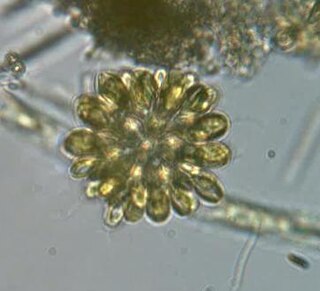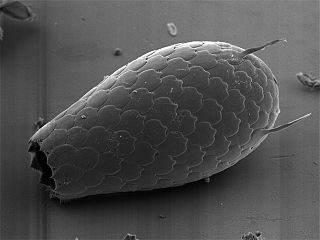
A flagellate is a cell or organism with one or more whip-like appendages called flagella. The word flagellate also describes a particular construction characteristic of many prokaryotes and eukaryotes and their means of motion. The term presently does not imply any specific relationship or classification of the organisms that possess flagella. However, the term "flagellate" is included in other terms which are more formally characterized.

The Stramenopiles, also called Heterokonts, are a clade of organisms distinguished by the presence of stiff tripartite external hairs. In most species, the hairs are attached to flagella, in some they are attached to other areas of the cellular surface, and in some they have been secondarily lost. Stramenopiles represent one of the three major clades in the SAR supergroup, along with Alveolata and Rhizaria.

The alveolates are a group of protists, considered a major clade and superphylum within Eukarya. They are currently grouped with the stramenopiles and Rhizaria among the protists with tubulocristate mitochondria into the SAR supergroup.

The synurids are a small group of heterokont algae, found mostly in freshwater environments, characterized by cells covered in silica scales.

The axodines are a group of unicellular stramenopiles that includes silicoflagellate and rhizochromulinid algae, actinomonad heterotrophic flagellates and actinophryid heliozoa. Alternative classifications treat the dictyochophytes as heterokont algae, or as Chrysophyceae. Other overlapping taxonomic concepts include the Actinochrysophyceae, Actinochrysea or Dictyochophyceae sensu lato. The grouping was proposed on the basis of ultrastructural similarities, and is consistent with subsequent molecular comparisons.

The euglyphids are a prominent group of filose amoebae that produce shells or tests that in most described species is reinforced by siliceous scales, plates, and sometimes spines, but this reinforcement is absent in other species. These elements are created within the cell and then assembled on its surface in a more or less regular arrangement, giving the test a textured appearance. There is a single opening for the long slender pseudopods, which capture food and pull the cell across the substrate.

Bicosoecida (ICZN) or Bicosoecales/Bicoecea (ICBN) is an order of Bikosea, a small group of unicellular flagellates, included among the stramenopiles. Informally known as bicosoecids, they are a small group of unicellular flagellates. The cells are free-living, with no chloroplasts, and in some genera are encased in a lorica.

Monadofilosa is a grouping of Cercozoa. These organisms are single-celled amoeboid protists.

Sagenista is a group of heterokonts containing the labyrinthulids and Eogyrea, a class of yet uncultured protists. Originally, it contained the Labyrinthulids and bicosoecids. The bicosoecids have been removed, and Eogyrea were added, in order to make the group monophyletic.

The ochrophytes is a group of mostly photosynthetic stramenopiles (heterokonts). Their plastid is of red algal origin.

Pseudofungi is a grouping of heterokonts, also known as the Heterokontimycotina. It consists of the Oomycota and Hyphochytridiomycetes. Although numerous biochemical, ultrastructural, and genetic traits clearly place them in the heterokonts, their growth form and mode of nutrition (osmotrophy) resemble that of fungi.

Bigyra is a possibly paraphyletic phylum of heterotrophic organisms belonging to the Stramenopile lineage. It includes the groups Bicosoecida, Opalinata and Labyrinthulea, as well as several small clades that were initially discovered through environmental DNA samples: Nanomonadea, Placididea, Opalomonadea and Eogyrea.

Opalozoa is a subphylum of heterotrophic protists of the phylum Bigyra, and is the sister group to Sagenista. Opalozoans are non-photosynthetic heterokonts that are ancestrally phagotrophic but many times have evolved to be osmotrophic saprotrophs in the gut of vertebrate animals.
The genus Labyrinthula is part of the protist group Labyrinthulomycetes and contains thirteen species. The major feature of this genus is the formation of an ectoplasmic net secreted by specialized organelles called bothrosomes which surrounds the colony, which is also used by Labyrinthula for moving. The protist reproduces by zoosporulation as it sets some flagellated spores free from a sporangium. One of the flagella of the zoospores has stiff tripartite hairs (mastigonemes) - the defining characteristic of the stramenopiles.
Platysulcus is an eukaryotic microorganism that was recently discovered to be the earliest diverging lineage of the Heterokont phylogenetic tree. It is the only member of the family Platysulcidae, order Platysulcida and class Platysulcea, of uncertain taxonomic position within the phylum Bigyra. It contains the only species P. tardus.

Picophagea, also known as Synchromophyceae, is a class of photosynthetic stramenopiles. The chloroplast of the Synchromophyceae are surrounded by two membranes and arranged in a way where they share the outer pair of membranes. The entire chloroplast complex is surrounded by an additional two outer membranes.

The genus Aplanochytrium is part of the class Labyrinthulomycetes. It is a sister genus of Labyrinthula and thraustochytrids. The major characteristic of all three genera is the production of an extension of the plasma membrane and the ectoplasm called the ectoplasmic net, but its use is different in each genera. Aplanochytrium cells are not embedded in the ectoplasmic net but can move by gliding on the ectoplasmic threads.
Rictus is a genus of Bikosea, a small group of unicellular flagellates, included among the heterokonts.

Thraustochytrids are single-celled saprotrophic eukaryotes (decomposers) that are widely distributed in marine ecosystems, and which secrete enzymes including, but not limited to amylases, proteases, phosphatases. They are most abundant in regions with high amounts of detritus and decaying plant material. They play an important ecological role in mangroves, where they aid in nutrient cycling by decomposing decaying matter. Additionally, they contribute significantly to the synthesis of omega-3 polyunsaturated fatty acids (PUFAs): docosahexaenoic acid (DHA), and eicosapentaenoic acid (EPA), which are essential fatty acids for the growth and reproduction of crustaceans. Thraustochytrids are members of the class Labyrinthulea, a group of protists that had previously been incorrectly categorized as fungi due to their similar appearance and lifestyle. With the advent of DNA sequencing technology, labyrinthulomycetes were appropriately placed with other stramenopiles and subsequently categorized as a group of Labyrinthulomycetes.
Synchroma is a genus of marine stramenopile algae containing two species with amoeboid morphology. They are grouped within the monotypic family Synchromaceae and order Synchromales as part of an independent clade of ochrophytes known as Picophagea or Synchromophyceae.




















